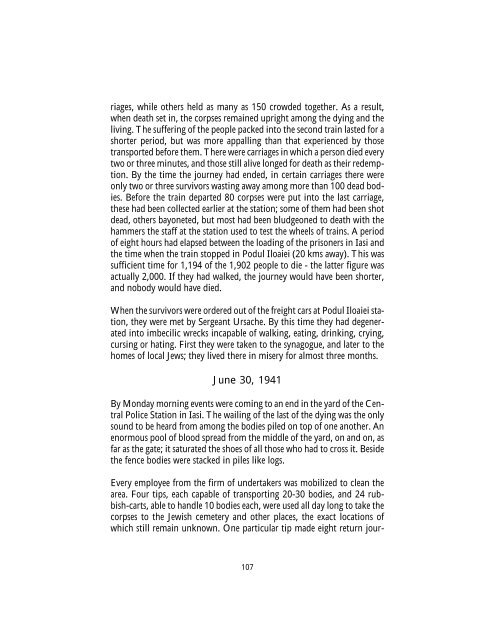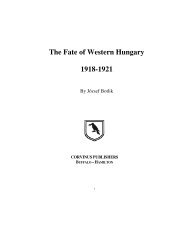Holocaust in Romania - Corvinus Library - Hungarian History
Holocaust in Romania - Corvinus Library - Hungarian History
Holocaust in Romania - Corvinus Library - Hungarian History
- No tags were found...
You also want an ePaper? Increase the reach of your titles
YUMPU automatically turns print PDFs into web optimized ePapers that Google loves.
iages, while oth ers held as many as 150 crowded to gether. As a re sult,when death set <strong>in</strong>, the corpses re ma<strong>in</strong>ed up right among the dy <strong>in</strong>g and theliv<strong>in</strong>g. The suffer<strong>in</strong>g of the peo ple packed <strong>in</strong>to the sec ond tra<strong>in</strong> lasted for ashorter period, but was more appall<strong>in</strong>g than that ex pe ri enced by thosetrans ported be fore them. There were carriages <strong>in</strong> which a person died ev erytwo or three m<strong>in</strong> utes, and those still alive longed for death as their re demp -tion. By the time the jour ney had ended, <strong>in</strong> certa<strong>in</strong> car riages there wereonly two or three sur vi vors wast<strong>in</strong>g away among more than 100 dead bod -ies. Be fore the tra<strong>in</strong> departed 80 corpses were put <strong>in</strong>to the last car riage,these had been collected earlier at the sta tion; some of them had been shotdead, oth ers bay o neted, but most had been blud geoned to death with thehammers the staff at the station used to test the wheels of tra<strong>in</strong>s. A periodof eight hours had elapsed be tween the load<strong>in</strong>g of the prisoners <strong>in</strong> Iasi andthe time when the tra<strong>in</strong> stopped <strong>in</strong> Podul Iloaiei (20 kms away). This wassuf fi cient time for 1,194 of the 1,902 peo ple to die - the lat ter fig ure wasac tu ally 2,000. If they had walked, the jour ney would have been shorter,and nobody would have died.When the sur vi vors were ordered out of the freight cars at Podul Iloaiei sta -tion, they were met by Ser geant Ursache . By this time they had de gen er -ated <strong>in</strong>to im be cilic wrecks <strong>in</strong> ca pa ble of walk <strong>in</strong>g, eat <strong>in</strong>g, dr<strong>in</strong>k<strong>in</strong>g, cry <strong>in</strong>g,curs <strong>in</strong>g or hat <strong>in</strong>g. First they were taken to the syn a gogue, and later to thehomes of lo cal Jews; they lived there <strong>in</strong> mis ery for almost three months.June 30, 1941By Monday morn <strong>in</strong>g events were com <strong>in</strong>g to an end <strong>in</strong> the yard of the Cen -tral Po lice Station <strong>in</strong> Iasi. The wail<strong>in</strong>g of the last of the dy <strong>in</strong>g was the onlysound to be heard from among the bod ies piled on top of one an other. Anenor mous pool of blood spread from the middle of the yard, on and on, asfar as the gate; it sat u rated the shoes of all those who had to cross it. Be sidethe fence bod ies were stacked <strong>in</strong> piles like logs.Every em ployee from the firm of un der tak ers was mobilized to clean thearea. Four tips, each capable of trans port <strong>in</strong>g 20-30 bod ies, and 24 rub -bish-carts, able to handle 10 bod ies each, were used all day long to take thecorpses to the Jewish cem e tery and other places, the ex act lo ca tions ofwhich still re ma<strong>in</strong> un known. One par tic u lar tip made eight re turn jour -107
















